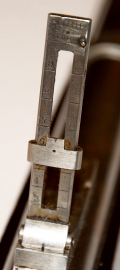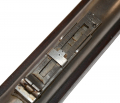site search
online catalog
WHITNEYVILLE PLYMOUTH NAVY RIFLE

$4,500.00 SOLD
Quantity Available: None
Item Code: 490-3012
This is a very good condition rifle that usually shows up in lesser condition from ship-board use and navy storage. It is complete and all original, with the correct ramrod and unique rear sight. The Whitney Model 1861 Navy Rifle, AKA “Plymouth Rifle,” was the brainchild of John A. Dahlgren, who began testing the idea of a .69 caliber rifle for the U.S. Navy on the 1858 voyage of the USS Plymouth, hence one of the names applied to it. Dahlgren wanted a large-caliber short rifle for shipboard use and used the French carabine-a-tige as a model. He also wanted a heavy barrel to compensate for its recoil and originally had the idea of fitting it with a Bowie-knife style bayonet that would be useful has a hand-held weapon and for other shipboard tasks.
As produced by Whitney for the Navy on a July 1861 contract, the rifle was lighter than Dahlgren envisioned and utilized a saber bayonet supplied by Collins, but mounted a 34-inch .69 caliber rifled barrel secured by two bands, with a long French style rear sight graduated to 1,000 yards. Whitney’s contract called for 10,000 rifles with deliveries to start in February 1862, but difficulties in obtaining barrels delayed production and delivery for a year. Five sample rifles were delivered in October 1862 and regular deliveries started in February 1863, with 5,300 delivered that year and the remaining 4,695 in 1864. This one is crisply dated 1863 on the barrel and 1864 on the lockplate, indicating assembly early in 1864, and is numbered on the breachplug tang 5425, technically not a serial number, but a mating number for a brass-hilted sword bayonet that had to be hand-fitted (and, to the consternation of Navy ordnance officers was not interchangeable until modified.) Nevertheless, the guns do seem to have been completed, numbered, and delivered more or less in sequence, which would place this rifle, if not among the 500 delivered on 2 January 1864 to the New York Navy Yard, perhaps in the second 500 delivered that month or the lot of 500 delivered in February.
The metal rates very good or better for condition: smooth surface in the bright, showing only a few thin gray marks, a bit of shallow freckling on the buttplate tang and just two or three very, very small dings on the right of the barrel, at rear of the lower band. Bayonet lug and both sights are in place. The unique French pattern rear sight is original to the rifle and complete. The ramrod is the correct pattern. Both swivels are in place- on the lower band and bottom of the buttstock near the buttplate. The nipple is not battered and the neighboring breech area shows no pitting. As is correct, the bolster is made without clean-out screw. The triggerguard plate has the characteristic finger spur of the rifle. The buttplate shows a good “U.S.” on the tang. The lock is sharply marked 1864 at rear of the hammer and U.S. WHITNEY-VILLE forward with an eagle over the U.S. The eagle shows some wear. The lettering is fine. The sight markings are sharp. The barrel has a crisp V/P/eaglehead proof on left flat at breech, below which it has an F.C.W. barrel inspection stamp as well. The top flat has a very crisp 1863 date and number 5425 on the breachplug tang. There is no battering to the nipple and no corrosion around it. Action is excellent; bore is clean with excellent rifling.
The wood has good color, edges and fit to the metal, though it rates a tad under the metal for condition with a good number of old handling dings, scratches, and small pressure dents or shallow divots, all testimony of rough handling in naval service and storage. There is some very slight chipping at the breech on the left of breehplug. The lock apron shows good edges, though with a few small dings along the bottom. The left side flat shows various dings and scratches, but also has a very legible “F.C.W.” cartouche matching the initials on the barrel at left breech, those of Franklin C. Warner, at the time a civilian employee of the U.S.N. Bureau of Ordnance, hired to inspect navy arms and detailed to the Whitney plant in May 1863, where he served until completion of the contract, after which he received a commission in the navy.
These rifles were widely issued to navy vessels. McAulay lists the Nansemond, William Bacon, and Eutaw in the North Atlantic Blockading Squadron as among the first recipients in 1863, and thirty more vessels in 1864, including the Pawnee and Mendota. They saw service in small boat actions, in heavier fighting such as the attack of the Albemarle on the USS Mattabesset, and also in shore actions such as Tulifinny Crossroads in December 1864, where the color-bearer of the 5th Georgia was brought down by a Plymouth rifle in the hands of a sailor assigned to the howitzer section of a mixed force of sailors and marines attempting to cut the Charleston and Savannah Railroad. The rifles seem to have been well regarded. Some were even requested by the Potomac Flotilla to replace their Spencers, whose rimfire ammunition was dangerous in rough navy handling.
This is a nice example of a very interesting rifle that displays well and would benefit a Civil War long arms or naval collection and display. [sr] [ph:L]
DISCLAIMER: All firearms are sold as collector's items only - we do not accept responsibility as to the shooting safety or reliability of any antique firearm. All firearms are described as accurately as possible, given the restraints of a catalog listing length. We want satisfied customers & often "under" describe the weapons. Any city or state regulations regarding owning antique firearms are the responsibility of the purchaser. All firearms are "mechanically perfect" unless noted, but again, are NOT warranted as safe to fire.
~~~~~~~~~~~~~~~~~~~~~~~~~~~~~~~~~~~
THIS ITEM, AS WITH ALL OTHER ITEMS AVAILABLE ON OUR WEB SITE,
MAY BE PURCHASED THROUGH OUR LAYAWAY PROGRAM.
CLICK HERE FOR OUR POLICIES AND TERMS.
THANK YOU!
Inquire About WHITNEYVILLE PLYMOUTH NAVY RIFLE
For inquiries, please email us at [email protected]
Most Popular
Historical Firearms Stolen From The National Civil War Museum In Harrisburg, Pa »
Theft From Gravesite Of Gen. John Reynolds »
Cavalry Carbine Sling Swivel »
Fine Condition Brass Infantry Bugle Insignia »
featured item
12-POUNDER NAPOLEON PENDULUM HAUSSE CANNON SIGHT
This is an essential piece of artillery gear for crews manning the classic Civil War field-piece, the Model 1857 12-Pounder Napoleon. The pendulum hausse rear sight was the often-used replacement for the tangent scale rear sight that needed the… (1231-02). Learn More »























